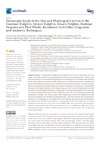Please use this identifier to cite or link to this item:
https://accedacris.ulpgc.es/jspui/handle/10553/107539
| Title: | Endoscopic study of the oral and pharyngeal cavities in the common dolphin, striped dolphin, risso’s dolphin, harbour porpoise and pilot whale: Reinforced with other diagnostic and anatomic techniques | Authors: | García de los Ríos y Loshuertos, Álvaro Soler Laguía, Marta Arencibia Espinosa, Alberto Martínez Gomariz, Francisco Sánchez Collado, Cayetano López Fernández, Alfredo Gil Cano, Francisco Seva Alcaraz, Juan Ramírez Zarzosa, Gregorio |
UNESCO Clasification: | 240119 Zoología marina 310901 Anatomía |
Keywords: | Buccal Cavity Common Dolphin (Delphinus Delphis) Dissection Endoscopy, et al |
Issue Date: | 2021 | Journal: | Animals | Abstract: | In this work, the fetal and newborn anatomical structures of the dolphin oropharyngeal cavities were studied. The main technique used was endoscopy, as these cavities are narrow tubular spaces and the oral cavity is difficult to photograph without moving the specimen. The endoscope was used to study the mucosal features of the oral and pharyngeal cavities. Two pharyngeal diver-ticula of the auditory tubes were discovered on either side of the choanae and larynx. These spaces begin close to the musculotubaric channel of the middle ear, are linked to the pterygopalatine re-cesses (pterygoid sinus) and they extend to the maxillopalatine fossa. Magnetic Resonance Imaging (MRI), osteological analysis, sectional anatomy, dissections, and histology were also used to better understand the function of the pharyngeal diverticula of the auditory tubes. These data were then compared with the horse’s pharyngeal diverticula of the auditory tubes. The histology revealed that a vascular plexus inside these diverticula could help to expel the air from this space to the naso-pharynx. In the oral cavity, teeth remain inside the alveolus and covered by gums. The marginal papillae of the tongue differ in extension depending on the fetal specimen studied. The histology reveals that the incisive papilla is vestigial and contain abundant innervation. No ducts were ob-served inside lateral sublingual folds in the oral cavity proper and caruncles were not seen in the prefrenular space. | URI: | https://accedacris.ulpgc.es/handle/10553/107539 | ISSN: | 2076-2615 | DOI: | 10.3390/ani11061507 | Source: | Animals [EISSN 2076-2615], v. 11 (6), 1507, (Junio 2021) |
| Appears in Collections: | Artículos |
SCOPUSTM
Citations
1
checked on Jun 8, 2025
WEB OF SCIENCETM
Citations
2
checked on Jun 8, 2025
Page view(s)
122
checked on Feb 25, 2024
Download(s)
153
checked on Feb 25, 2024
Google ScholarTM
Check
Altmetric
Share
Export metadata
Items in accedaCRIS are protected by copyright, with all rights reserved, unless otherwise indicated.
